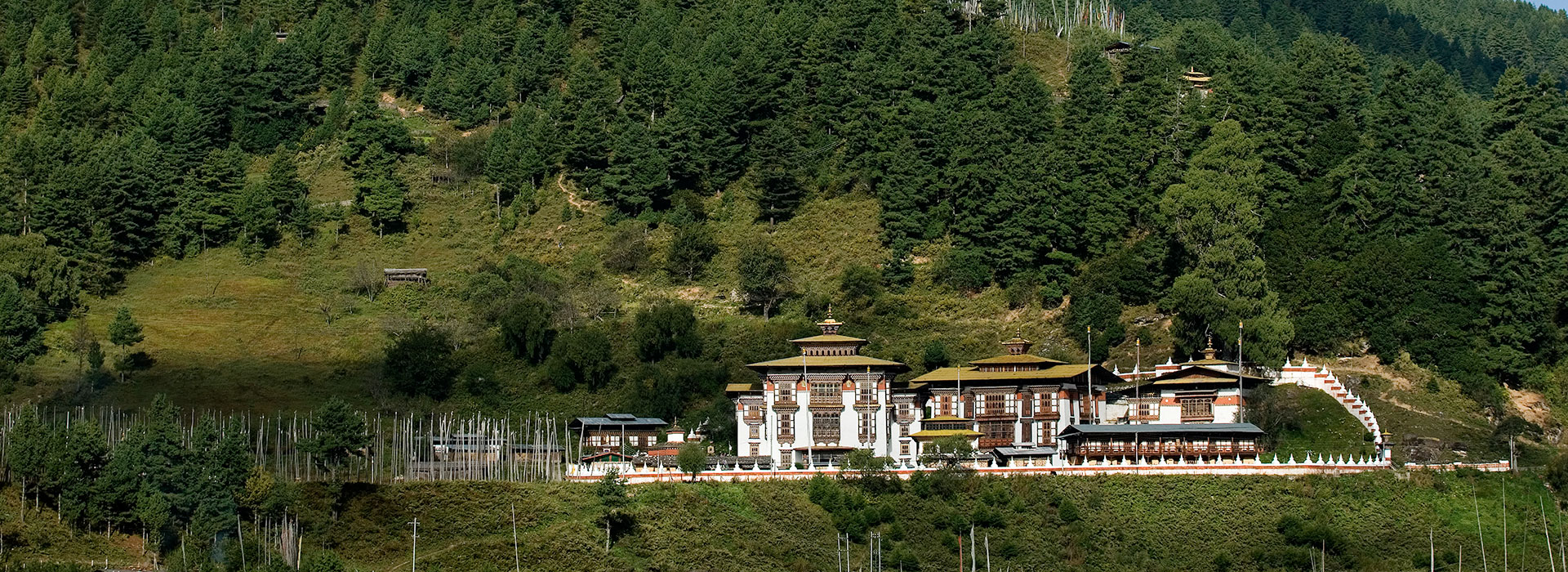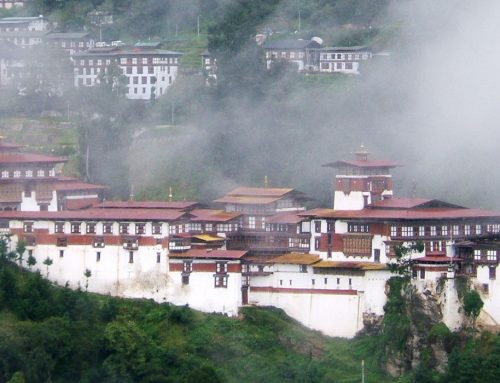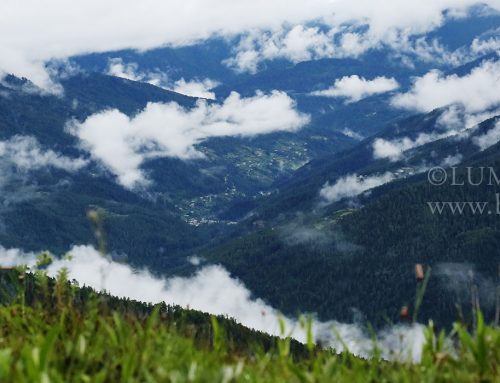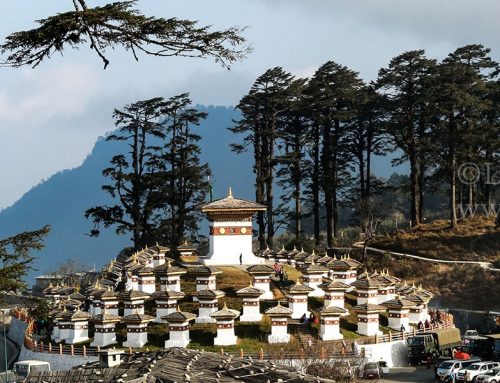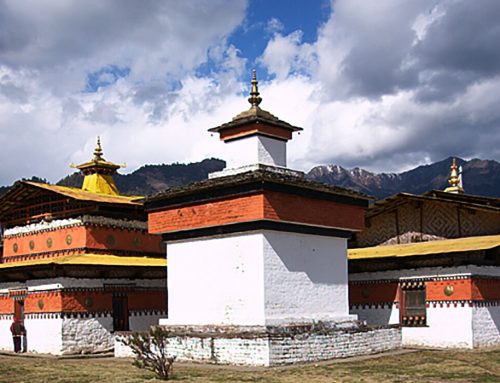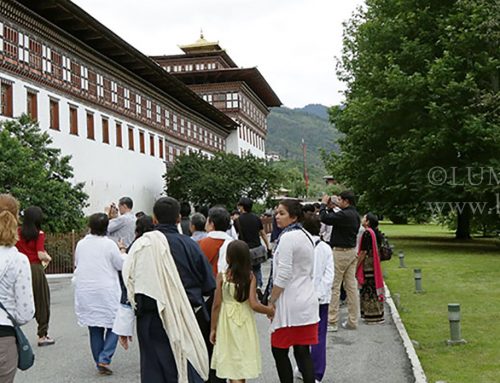- Duration: 10 nights / 11 days
- Accommodation: Hotels, Resorts and Guest Houses.
- Distance & Driving time:
- Paro to Thimphu – 54 Km – 2 Hrs
- Thimphu to Punakha – 76 Km – 3 Hrs
- Punakha to Wangdue – 17 Km – 40 Mins
- Wangdue to Gangtey – 66 Km – 2.5 Hrs
- Wangdue to Trongsa – 129 Km – 5 Hrs
- Trongsa to Bumthang – 68 Km – 3 Hrs
- Bumthang to Ura Valley – 55 Km – 2 Hrs.
- Highest altitude: Yotong La Pass (3425m)
- Visit to the largest Statue of Buddha in Bhutan
- Memorial Chorten
- Punakha Dzong (built in 1637)
- A Panoramic view of the Himalayas from the Dochula Pass (3140m)
- Chimi Lhakhang – “The Temple of Fertility”
- A farm house visit
- Excursion to famous Taktsang – “The Tiger’s Nest”
- Visit to Drugyal Dzong – “The Fortress of victory” (built in1644)
- Kichu Monastery
- Visit to Phobjikha/Gangtey Valley – “The most beautiful glacial valley of the Himalayas – The roosting ground for the rare Black-necked crane”
- Trongsa Dzong – “One of the most impressive fortress in Bhutan” (built in 1644)
- Jakar Dzong – “The Castle of White Bird” (built in 1667).
- Membartsho – “The Burning Lake”
- Excursion to beautiful Ura valley and Ura Temple (3100m)
- Tamshing Lhakhang
- Jambay Lhakhang – “The most spectacular Jambay Lhakhang festival is staged here every winter”
- Kurjey Lhakhang – “The body print of Guru Rimpoche is seen here”.
Day 01. Arrive Paro (Altitude 2280 m) by Druk Air flight
Your guide from Druk and Drukpa Travels will receive you at the airport and take you to the hotel. After lunch, visit the ruins of Drukgyal Dzong. It is 16 km northward from Paro proper.
The dzong was built in 1647 by Zhabdrung Ngawang Namgyel, the father and unifier of medieval Bhutan. The dzong was destroyed by fire and left in ruins. It was built to commemorate victories over Tibetan invasions.
On a clear day, you can see magnificent Mt. Jhomolhari (7,314m). On the way back, visit Kichu Lhakhang. It was built in 659 A.D by the Tibetan King Songtsen Gempo.
Kichu Lhakhang is one of the 108 monasteries the Tibetan king built across the Himalayan region to subdue the demons.The rest are found in other neighboring countries.
Dinner and overnight in Hotel.
Day 02. Paro – Thimphu (Altitude 2320 m, 54 km), Excursion to Taktsang Monastery
A special day with an excursion to the spectacular Taktsang (Tiger’s Nest) monastery.
After breakfast, a short drive takes us to Satsam Choeten, from there a 2 hour walk till the viewpoint of the monastery. The trail climbs through beautiful pine forest, many of the trees festooned with Spanish moss and an occasional grove of fluttering prayer flags.
We stop to rest and for light refreshments at the Taktsang Jakhang (cafeteria) and then walk a short distance until we see the clear view of Taktsang monastery. The main Lhakhang at the monastery was built around Guru Rimpoche’s meditation cave in 1684 by Gyaltse Tenzin Rabgye.
This incredible monastery clings to the edge of a sheer rock cliff that plunges 900 meters into the valley below. Legend has it that Guru Padmasambhava, the tantric mystic who brought Buddhism to Bhutan, flew here on the back of a flying tigress, said to be his favorite consort.
After lunch, visit Ta Dzong (built in1656 and renovated in 1968), an ancient watchtower, which now houses the National Museum. Below the museum is the Paro Rimpung Dzong (literally, meaning “Heap of Jewels,”) built in 1646 by Zhabdrung Ngawang Namgyel.
In the evening, drive to Thimphu. Overnight in Hotel.
Day 03 Thimphu Sightseeing: (Altitude 2320 m).
The day begins with a visit to the National Memorial Choeten (built in 1974) in honor of the late third King Jigme Dorji Wangchuk and the Dupthop Lhakhang, a nunnery. We then visit the National Library stocked with ancient Buddhist scriptures and the Institute of Zorigchusum. It is here where the tradition of Bhutan’s 13 arts and crafts are kept alive.
After lunch, we drive to the National Institute of Traditional Medicine where medicines are prepared according to ancient practices and to Lungtenzampa to see the Royal silver smiths at work and Bhutanese paper factory.
Other highlights include a visit to Tashichho Dzong. The dzong houses the office of His Majesty the king and is the seat of the national government and the Central Monastic Body. The dzong also serves as the summer residence of the Je Khenpo (Chief Abbot of Bhutan). Finally, visit the Handicrafts Emporium followed by shopping for souvenirs in the capital city.
Overnight in Hotel.
Day 04. Thimphu Sightseeing (Altitude 2320 m)
After breakfast, visit Folk Heritage Museum, Textile Museum, Changangkha Lhakhang and Philatelic office. After lunch, hike to Cheri Monastery and to the one of the largest statues of Buddha in the world.
Overnight in Hotel.
Day 05. Thimphu – Punakha: (Altitude 1310 m) (76 Kms, 3 hours drive).
After breakfast, drive to Punakha via Dochula Pass. If the weather is clear, we stop for a while to get a glimpse of the towering Himalayas.
On the way, stop for a while to view Chimi Lhakhang also called the “Temple of Fertility” built in the 15th century by Lama Drukpa Kuenley, who is popularly known as “The Devine Mad Man”.
Lunch at Punakha. After lunch, visit the Punakha Dzong built in 1637 by Zhabdrung Ngawang Namgyel. It is situated at the confluence of Pho Chu (Male River) and Mo Chu (Female River). The place was once the capital of Bhutan.
The construction of the Dzong is believed to have been foretold by Guru Rinpoche. The small dzong called Dzongchung that exists even today housed a statue of Buddha. It is said that Zhabdrung ordered the the architect, Zowe Palep, to sleep in front of the statue. While Palep was sleeping, the Zhabdrung took him in his dreams to Zangtopelri (Paradise) and showed him the palace of Guru Rimpoche. From his vision, the architect conceived the design for the new Dzong. The design was never put on paper. The Dzong was named Druk Pungthang Dechen Phodrang (Palace of Great Happiness). The war materials captured during the battle with Tibetans are preserved here. Punakha is still the winter residence of Je Khenpo.
The third king Jigme Dorji Wangchuck convened the first National Assembly in Punakha in 1952. Overnight in Hotel.
Day 06. Punakha – Gangtey (Altitude 3120 m)
We drive to the beautiful valley of Gangtey. It is a main seat of Peling tradition. En route sightseeing in the Wangduephodrang valley. Places of interest include: visit to Wangduephodrang Dzong (from outside). It was built in 1638. Legend has that as people were searching for the site of the Dzong, four ravens were seen flying away in four directions. This was considered auspicious sign representing the spread of Buddhism in the four points of the compass. The Dzong is situated at the confluence of Mo Chu and Dang Chu rivers.
Drive further to Gangtey. visit Gangtey Gompa. Gyaltse Pema Thinley, the grandson and mind reincarnation of Pema Lingpa founded the temple in 1613. And Tenzin Legpai Dhendup, the second reincarnation, built the temple. The present abbot, Kunzang Pema Namgyal, is the ninth re-incarnation. It is a Nyingmapa monastery and is affiliated to other Nyingmapa monasteries including Tamshing in Bumthang.
Explore Phobjikha valley. It is the winter roosting place for the Black-necked Cranes. Overnight at the Guest House.
Day 07. Gangtey – Trongsa – Bumthang (Altitude 2800 m, Distance 188 km, Drive Time 6 hour drives)
After breakfast, drive to Trongsa. Visit Trongsa Dzong, one of the most impressive dzongs in Bhutan. It was built in 1644 by Chogyal Minjur Tempa, who was sent by Zhabdrung to unify the eastern Bhutan, and was enlarged at the end of the 17th century by Desi Tenzin Rabgay. Trongsa Dzong is the ancestral home of the royal Royal Family and the first two hereditary kings ruled Bhutan from this Dzong.
Then visit Ta Dzong, an ancient watch tower. Recently, it was turned into the Monarchy Museum. The chapel inside the Ta Dzong is dedicated to Trongsa Penlop Jigme Namgyal. Overnight in Hotel.
Day 08. Bumthang Sightseeing: (Altitude 2800 m)
After breakfast, visit Jakar Dzong which literally means “The Castle of White Bird”. The dzong was built in 1667. Visit Jampa Lhakhang. It is said to have been built by King Srongtsen Gempo of Tibet in 659 A.D on the same day of Kichu Lhakhang in Paro. The temple was visited by Guru Rimpoche during his visit to Bumthang. Underneath the temple, it is believed there is a lake in which Guru Rinpoche hid several terma (religious treasure or relic).
One of the most special and spectacular festivals called Jampa Lhakhang Drup is held in every October. It is here where naked dance is performed to ward off evil spirits.
After lunch, visit Kurjey Lhakhang. Kurjey means the “body imprint.” The temple is built around a rock on which Guru Rinpoche had left his body imprint while meditating. The temple is considered one of the most sacred of temples.
Then visit Tamshing Lhakhang (temple of good message). It was established in 1501 by Terton Pema Lingpa and is one of the most important Nyingmapa temples in the country.
In the evening, visit Mebartsho. Literally, it means “The Burning Lake”. The lake is located en route Tang valley. Here, Terton Pema Lingpa displayed his supernatural power by diving into the lake with a butter lamp and came out with the lamp still lit and a treasure. And it is believed that Pema Lingpa discovered several religious treasures hidden by Guru Rinpoche from the lake.
Overnight in Hotel.
Day 09. Bumthang – Thimphu (212 km, Altitude 2320 m)
After an early breakfast, drive to Thimphu. Lunch will be served on the way. Over night in Hotel.
Day 10. Thimphu – Paro (Altitude 2320 m, Distance 58 km Drive Time 1 hour)
After breakfast, shopping and photography in town/visit Handicraft Emporium. After lunch, drive to Paro. Visit a farm house.
Overnight in Hotel.
Day 11. Departure: (Altitude 2280 m)
In the early morning, drive to the airport and farewell.
- Hike to Khamsung Yulley Namgyal Choling temple.
- Visit a Bhutanese farm house.
- Mountain biking in Thimphu.
- Rafting in Punakha.
- Hike to Gogona valley in Gangtey.
- Excursion to Shingkhar village / Ura valley.
- Hike to Tangbi Lhakhang and Thangbi village.
- Hike to Tharpaling Monastery.
- Excursion to Dzongdrakha Lhakhang
- Excursion to Chelila pass.
- All Meals [Breakfast /Lunch/Dinner]
- Accommodation [Twin Sharing] Single Room Supplement Extra US $: 40 per room per night.
- All transportation within the country including airport transfers.
- Royalty & Govt. Taxes
- Entrance fees for Museums and Monuments only
- Visa Fee.
- Airport tax
- Tourism Development fund
- Sightseeing
- Druk Air fare.
- Insurance Premiums,
- Payments for service provided on a personal basis
- Cost for any services not mentioned in the “Cost Include head”.


